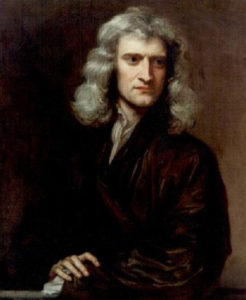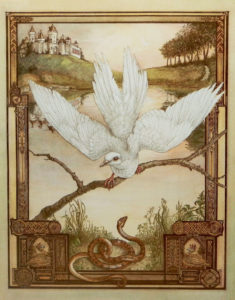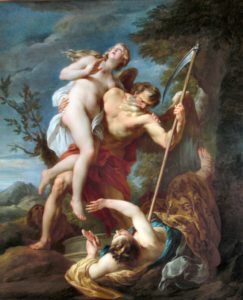we godless anti-metaphysicians still take our fire too, from the flame lit by the thousand-year old faith, the Christian faith which was also Plato’s faith, that God is Truth; that Truth is ‘Divine’
~ Friedrich Nietzsche
What does it mean to say something is true?
Truth is one of those words that we can’t quite define, but whose meaning we can’t quite deny. When we say something is true, we usually mean that it is an accurate representation of reality. We act as if truth transcends belief, that something is true whether you believe it or not.
Humans have been around far longer than philosophical discussions of truth. For most of human history truth was expressed through stories, through folk wisdom. There are stories floating around the contemporary zeitgeist that are older than anyone alive today, older than any book, older than any nation, and older than any language spoken today. In all likelihood, there are stories older than humanity — archetypal stories first crafted by the descendants of modern humans.
Some of these old stories are religious stories, like the one about a young Gautama Buddha meditating under a Bodhi tree. Or the story about Ziusudra building an ark to survive the great flood, a precursor to the flood narrative in the Epic of Gilgamesh, in turn a precursor to the dozens of other flood stories throughout the last 5,000 years, including Manu in Hinduism, Deucalion in Greek Mythology, and Noah in the Genesis flood narrative. Some cultures really liked telling the flood story.
Think of all the cultures and civilizations that rose and fell in the last 5,000 years, or 10,000 years, or even 50,000 years. Think of all the songs that were sung, stories that were lived, and all that was forgotten in the passage of time. It is incredible that any story would survive more than a single lifetime, yet some stories not only survived, they flourished and replicated into dozens of ascendant cultures. It’s as if some stories represented reality better than other stories, that there was an evolutionary advantage to those stories.
In the long tail of human evolutionary history, the expression and articulation of truth was not accomplished through epistemological debate, but through symbolism and narrative. For better or worse, symbolism is all we had.
Symbols are visual indicators of an idea. A symbol can be an image, a mark, a totem, an emoji — pretty much any visual representation.
Importantly, symbols predate modern writing systems. It is common to see ancient stories represented symbolically. Symbols represent and express ideas that we consider true.
Symbolic representations are fascinating because they can express the most ancient folk wisdom, which are often literally false, yet they intimate deeper truths that are not easy to articulate outside their narrative forms.
Truth in Story Form
As fascinating as ancient symbols and mythological stories are, in modern times we imagine ourselves as having advanced through scientific literacy, applying the scientific method to discover truth. Unfortunately, we’re still as human as our ancestors.
Let’s consider the following scientific truth:

“There exists a universal force of gravity between all objects, which is inversely proportional to the square of the distance between them.”
This is Newton’s law of universal gravity. It’s obviously more true than a flood myth. We call it a natural law because it’s considered irrefutably true.
Let’s consider another scientific truth: the force of gravity is curved spacetime. This is what Einstein proposed, and the truth of this claim has consistently been verified in experimentation. In other words, Relativistic Physics makes the story of Newtonian Physics literally false.
We all pretend the law of universal gravity is true, and we simultaneously believe Einstein was correct, while also believing that both of those claims cannot be true at the same time. As I said before, we are as human as our ancestors. Engineers still use Newtonian Mechanics when designing cars and airplanes. The only time we use Relativistic Physics is when we’re dealing with extreme mass or velocity such that the error in Newtonian Mechanics would be catastrophic.
In other words, within the narrow band of physics that humans operate within, we can safely rely on Newtonian mechanics. This narrow band is analogous to the tiny sliver of the electromagnetic spectrum that we call visible light. Just like a painter safely ignores colors beyond the visible spectrum, mechanical engineers safely ignore curved spacetime — your car will not drive at the speed of light.
We don’t know the absolute truth of gravity, but we know that the story of Newtonian Mechanics is literally false. We can say it’s figuratively or metaphorically true, but we cannot say it’s literally true. We hold this false belief because it’s incredibly powerful, and dangerous to ignore. Perhaps in the future we will develop the ability to intuit curved spacetime, but until then it’s best for everyone in society if we continue to believe the literally false story of an invisible force pulling us down to the ground.
Disclaimer: disregarding Newton’s law of gravity may result in permanent injury or death.
Truth in Symbol Form
As with Newton’s Law of Gravity, some symbolic stories are literally false but express a deeper truth. Let’s consider a different story:

“I am sending you out as sheep in the midst of wolves, so be wise as serpents and innocent as doves.”
This story is pretty easy to interpret. Wolves represent the danger that exists in the world, especially to the humans (who are as vulnerable as sheep to a pack of wolves). Snakes are a symbol for sly craftiness and cunning. Doves are symbolic for peace and purity. Rather than becoming like the danger that threatens you, one can survive the danger through cunning tempered by innocence. The truth in this story is obvious to even a non-believer like myself.
Imagine if the story was: “be as cruel as wolves and tear the sheep to pieces.” There were of course stories like that, but those stories didn’t survive as well, or rather, the people who told those stories did not survive as well.
That the sheep, dove, and snake are Christian symbols should be irrelevant to the underlying truth of the story. A better way to understand the history of this story is that it predates both modern Christianity as well as secular humanism. In fact, both secular humanism and modern Christianity share a common ancestor with the medieval Christian ethos that popularized and preserved this story and its symbolism. We act out the truth of this story not because secular humanists think this story is good advice, or that modern Christians believe this story is gospel, we act out the truth of this story because our ancestors acted out the truth of this story and survived the wolves. The story is true in ways we can barely comprehend.
While religious stories can express underlying truth claims, one can certainly fault modern religious teachings for not being forthcoming about the specific interpretations that would make a literally false story true. It’s not a secret amongst engineers and physicists that Newtonian Mechanics is literally false. We all know it’s literally false. There is no reason that religious teachers cannot apply Einstein’s views about conjecture and refutation: “No amount of experimentation can ever prove me right; a single experiment can prove me wrong.”
Importantly, stories of doves and snakes, as well as Newtonian Mechanics, succeeded not because of a lack of falsification, but primarily because of their success. Newtonian Mechanics has explanatory power. Likewise, a well-interpreted reading of the symbolism of snakes and doves also has explanatory power, despite the fact both stories are literally false.
Science has provided tools to bring the unknown into the known, to properly traverse the infinite expanse of knowable existence. A hallmark of the physical sciences is the integration of conflicting stories into more universal stories. For example, the story of electricity and the conflicting story of magnetism are now known by the more universal story of electromagnetism. One of the most active areas of research in modern physics is the integration of the conflicting stories of Quantum and Relativist Physics. The physical sciences seek to understand and unify where their stories conflict.
There’s no obvious reason religious stories don’t do the same. It seems to be a sin of pride to claim that something like the Genesis story might be literally true. It is at best a profound psychological truth, and it may underlie the foundation of modern culture, but the earth isn’t 6,000 years old. Pretending the earth is 6,000 years old, when you know it’s not, is a surefire way to see the collapse of your culture (pride cometh before a fall).
Truth in Hierarchies
Truth is often qualified. There are scientific truths, religious truths, and even mathematical truths. We seem to believe that there are multiple levels of truth, a kind of hierarchy of truth, where some claims are more true than others. By dependence alone we can say that mathematics is more true than, say, physics, which is more true than chemistry, which is more true than biology, and so on all the way into a postmodern humanities class that denies the existence of truth and hierarchies (if you’re the bottom of the truth hierarchy, you’d probably hate hierarchies too).
We act as if all the qualified truths point to something beyond us, something transcendent, a meta truth, or even better: a universal truth. To Nietzsche’s point, we might as well just call it “Divine”.
Let’s take a tangent and consider the following conjecture: If some truths are more universal than others, then we can (by definition) compare truths, which means we can (by definition) sort truth, which means we can quantify truth. To my knowledge, no serious effort has ever been made to quantify truth, yet it is the inevitable consequence of the near universally agreed upon notion that some truths are more universal than others.
Measuring Truth
Historically, geometric models of nature were far too complex and chaotic to represent mathematically. Yet today, mathematics does quantify these chaotic systems through Fractal Geometry. It stands to reason that we can analogously quantify truth. The vagaries of truth are no more chaotic than nature itself.
To understand Fractal Geometry, let’s start with the square-root of negative one.
Unfortunately, there is no square-root of -1. You can’t multiply a number to itself and have the answer be -1. Yet we can pretend, we can pretend there exists a square-root of -1. We can imagine an entire number line where the square-root of -1 exists.
These are known as complex numbers, or sometimes as imaginary numbers. A complex number has two parts: a real part (from the real number line), and an imaginary part (the square-root of -1).
The existence of the square-root of negative one is as literally false as any religious story. Yet complex numbers are a necessary part of Fractal Geometry. They are a way to calculate self-replicating and chaotic systems, a literally false story intimating a deeper truth.
We see it all around us: in trees, in clouds, and in arcs of lightning. Nature is self-replicating and chaotic.
Clouds are not spheres, mountains are not cones, coastlines are not circles, and bark is not smooth, nor does lightning travel in a straight line.
~ Benoit Mandelbrot
Here we have a profound natural truth revealed by pretending the square-root of -1 exists.
The most well-known fractal, and a symbol representing Fractal Geometry, is the Mandelbrot set. To visualize this set, all you need to do is plot imaginary numbers on a 2-dimensional plane, and calculate which of the imaginary numbers, c, is bounded by the following equation:
In other words, square the coordinates again and again and see if it stays bounded (that is, doesn’t get infinitely bigger). I wrote some code to do the calculations for you. This is the famous Mandelbrot set:
I set an interval timer so you can see what happens at each interval of z. The colors get a little closer to the Mandelbrot set at each interval. If I would have used a real number plane rather than the imaginary plane, then you would be looking at a circle.
The edges of the Mandelbrot set are always “rough”, with chaotic self-replicating patterns. At any resolution, the Mandelbrot set will reveal infinite chaotic patterns. There are some great videos zooming into the edge of a Mandelbrot set — when you watch these, remember that this is based on assuming the existence of the square-root of -1.
Natural systems are not all equally chaotic; some are more chaotic than others. This can be quantified by Fractal dimension. This means we can meaningfully compare the chaos of clouds, mountains, coastlines, arteries, leaves, stock markets, and even the Mandelbrot set itself. In other words, we know which systems are more chaotic than others. We can compare, sort, and quantify the chaos of different systems.
Let’s imagine a measurement of truth that is analogous to fractal dimension. A measurement of the universality of a given truth claim, a truth dimension.
Truth dimension
Perhaps a Truth Dimension is a measure of contextual abstraction, that is, how abstract is a given truth claim? Obviously, this would always be relative to human psychology, but I see no reason why this couldn’t be quantifiable in a useful way.
Let’s say the truth dimension for a mathematical axiom is 1, that is, perfectly universal and unquestionable. It would be true “by definition”. Maybe the truth dimension of electromagnetism would be something like 1.5, and the truth dimension of Newtonian mechanics is something like 3, measurably less true than Relativistic or Quantum Physics. Likewise, certain religious stories would have a truth dimension of something like 3 or higher.


